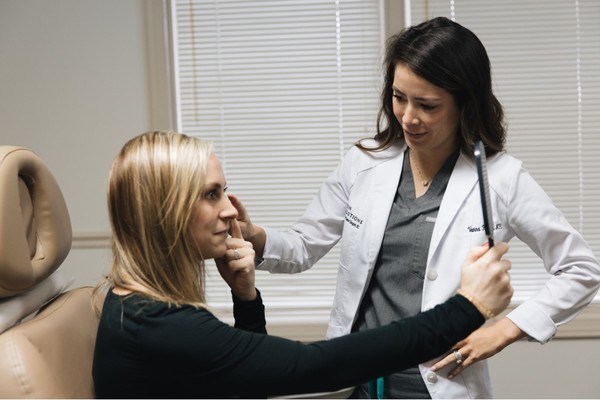
Rosacea is a chronic skin condition that is often characterized by flushing or redness in the cheeks, nose and forehead. Tiny visible blood vessels and a ruddy appearance are also symptoms of this common skin disorder. Rosacea can develop on any skin type and at any age, although it is more commonly seen in fair-skinned individuals over the age of 30. If left untreated, symptoms may worsen and become more severe.
There are four main types of rosacea: Papulopustular, Phymatous, Erythematotelangiectaticand Ocular. It is common to have symptoms from more than one type of rosacea at a time. It’s possible to also have symptoms such as a stinging sensation of the affected areas, dry patches that feel rough in texture, bumps on your eyelids, and enlarged pores. In some severe cases, a person may also have impaired vision. These symptoms may develop seemingly randomly and stick around for days or weeks before vanishing again.
TYPES OF ROSACEA:
- Papulopustular rosacea – Swollen, acne-like breakouts, redness and flushing.
- Phymatous rosacea – Thickened, bumpy skin.
- Erythematotelangiectatic rosacea – Redness or flushing of the mid face, visible blood vessels. This is what most people think of when they think of rosacea.
- Ocular rosacea – Red, irritated eyes, swollen eyelids, eyelids can be swollen, the appearance of a sty.
HOW DO I KNOW IF I HAVE ROSACEA?
There are no medical tests to tell if a person has rosacea, however, one of our dermatology specialists will be able to determine whether or not you have rosacea based on some key factors. Your dermatology specialist may ask questions about your overall health, medications you are taking or any existing health conditions you have that may affect your skin or eyes before determining what rosacea treatment is best for you. In addition, if your dermatology specialist may want to test you for other medical conditions, such as Lupus, that can have an effect on your skin health.
CAN I BE CURED?
There is no cure for rosacea, however, treatments can help reduce the appearance of redness and make your skin more comfortable. Over time, rosacea symptoms may worsen or become permanent so it is important to seek treatment from your dermatology specialist right away if you are concerned that you may have rosacea. A crucial part of treatment is learning what daily behaviors or factors can trigger a flare-up.
COMMON ROSACEA TRIGGERS:
- Spicy foods
- Cold wind on the face
- Rapid change in temperature such as going from the warmth of indoors to the cold outdoors (this is especially true of winter time)
- Hot showers
- Direct sunlight
WHAT TREATMENTS ARE AVAILABLE?
After a health assessment, your dermatology specialist will be able to help educate you on living with rosacea and determine the best possible course of treatment for you. Some treatments are purely preventative such as wearing sunscreen and sun protective clothing daily. Other treatments, like Intense Pulsed Light (IPL) can reduce the redness and the appearance of blood vessels common in rosacea sufferers. For more mild cases, learning what types of facial cleanser or moisturizers to use and how to take a more gentle approach to face washing is all it takes. For more severe cases, medications or surgery may be necessary.
If you would like to learn more about living with rosacea or if you would like to talk to a dermatology specialist about treatment options that work best for you, schedule an appointment with an office closest to you today!
Resources: American Academy of Dermatology, Rosacea.org
